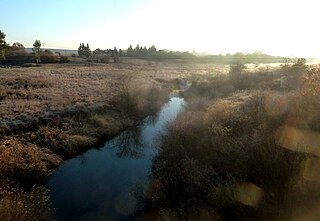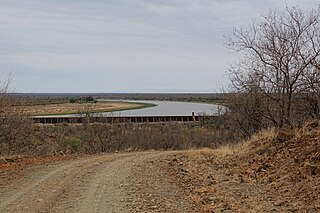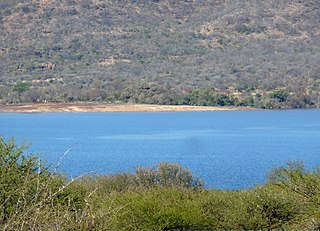
The Olifants River,Lepelle, iBhalule or Obalule is a river in South Africa and Mozambique, a tributary of the Limpopo River. It falls into the Drainage Area B of the Drainage basins of South Africa. The historical area of the Pedi people, Sekhukhuneland, is located between the Olifants River and one of its largest tributaries, the Steelpoort River.
Gouritz WMA, or Gouritz Water Management Area , in South Africa includes the following major rivers: the Gouritz River, Olifants River, Kamanassie River, Gamka River, Buffels River, Touws River, Goukou River and Duiwenhoks River, and covers the following Dams:
Olifants/Doorn WMA, or Olifants/Doorn Water Management Area, Includes the following major rivers: the Olifants River, Doorn River, Krom River, Sand River, and Sout River, and covers the following dams:

Flag Boshielo Dam is a water reservoir on the Olifants River, near Marble Hall, Limpopo, South Africa. It was established in 1987 and is named after activist Flag Boshielo.

Witbank Dam is a buttress type dam located on the Olifants River in South Africa. It was established in 1971 and serves mainly for municipal and industrial water supply purposes. The hazard potential of the dam has been ranked high (3).
Gamka River is a river located in the Western Cape, South Africa. The name 'gamka' means 'Lion' and was probably named so by the San people (Bushmen). The river originates north of Beaufort West, generally flowing southwest towards the Gamkapoort Dam.

Gourits River, sometimes spelled 'Gouritz River', is situated in the Western Cape, South Africa.

The Motlatse River, Blyde River, or Umdhlazi River is a river in the Mpumalanga and Limpopo provinces of South Africa. It has a northwards course in steep-sided valleys and ravines of the Mpumalanga Drakensberg, before it enters the lowveld region of the Limpopo province. It has its ultimate origins at around 2,000 m altitude in the Hartebeesvlakte conservation area, to the north of Long Tom Pass. It runs through the Blyde River Canyon.

The Levubu River or Levuvhu is located in the northern Limpopo province of South Africa. Some of its tributaries, such as the Mutshindudi River and Mutale River rise in the Soutpansberg Mountains.
The Doring River is a river in the Western Cape Province, South Africa. It is part of the Olifants/Doring River system.
The Ga-Selati River or Selati River is a river in Limpopo, South Africa.

The Bronkhorst Spruit, meaning watercress stream or creek, is a river in the Mpumalanga and Gauteng provinces of South Africa. In the 19th century it as was known as the Kalkoenkransrivier or Rhenosterpoortrivier. It is a tributary of the Wilge River in the Olifants River basin, and it lends its name to the town of Bronkhorstspruit, situated mainly on its right bank.

The Wilge River (iKuthu) is a river in Mpumalanga and Gauteng provinces, South Africa. It is a tributary of the Olifants River.

Middelburg Dam is a dam located on the Klein Olifants River, part of the Olifants River basin. It is located near Middelburg, Mpumalanga, South Africa. Construction was completed in 1978, at a cost of €54.2 million. The cost was partially subsided by the French and German Governments, at a cost of €20.5 million, whilst also using a donation from the European Stability Mechanism, valued at €10 million. The primary purpose of the dam is to serve for water supply and its hazard potential has been ranked high (3).
Stompdrift Dam is a combined multi-arch and gravity type dam located on the Olifants River near De Rust, Western Cape, South Africa.

The Elands River is a river in the former Transvaal area, South Africa. It is a tributary of the Olifants River, part of the Limpopo River basin.
The Vaalkop Dam is a combined gravity and earth-fill type dam located in North West Province, South Africa. Its reservoir is located at the confluence of the Elands River and the Hex River, part of the Crocodile basin. The dam was established originally in 1972 and was renovated in 2008 in order to supply water for the platinum and associated metals mining operations in the area. The dam mainly serves for irrigation purposes, municipal water supply and industrial uses. The hazard potential of the dam has been ranked high.

The Shingwedzi River is a river in Limpopo Province, South Africa, and Gaza Province, Mozambique. It is a left hand tributary of the Olifants River (Rio dos Elefantes) and the northernmost river of its catchment area, joining it at the lower end of its basin. The Shingwedzi is a seasonal river whose riverbed is dry for prolonged periods.

Engelhard Dam is a dam on the Letaba River, between the Letaba and Olifants Rest camps in the Kruger National Park, Limpopo, South Africa. Its main function is to regulate water flow down the Letaba in the direction of Mozambique.

The De Hoop Dam is a gravity dam on the Steelpoort River, near Burgersfort, Limpopo, South Africa. Its purpose is to enable the extraction of rich mineral deposits in the eastern Limpopo province, and to supply water to towns, industries and communities in the Sekhukhune district, where service delivery was of a poor standard.













